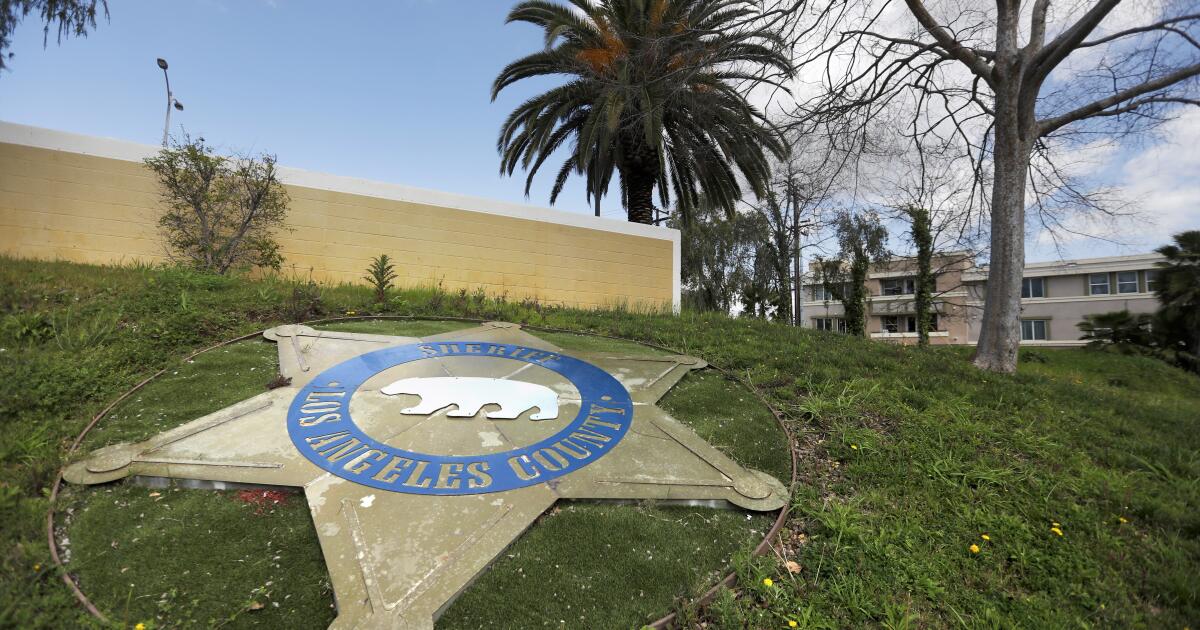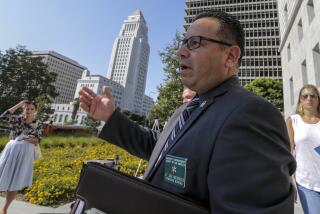New deputy ‘gang’ forming in L.A. County Sheriff’s Department, lawsuit alleges
The Los Angeles County sheriff’s station in East L.A.
(Francine Orr/Los Angeles Times)
By
Keri BlakingerStaff Writer
Published Feb. 8, 2023 Updated Feb. 10, 2023 9:34 AM PT
Los Angeles County Sheriff’s deputies are forming a new “gang” in the agency’s East L.A. station, according to a deputy who alleges in a lawsuit he was abused when he refused to join the group.
Amayel Garfias filed his lawsuit in Superior Court last month, claiming he was harassed, assaulted and purposely put in harm’s way by an alleged member of the new “gang.” Both the county and several sheriff’s employees should be held responsible for allowing the East L.A. station to remain under “gang” control, the lawsuit states.
Citing the pending litigation, the Sheriff’s Department declined to comment on the lawsuit, but said the incident is under investigation.
“The Department does not tolerate deputy gangs or conduct contrary to our values,” department spokeswoman Lorena Rodriguez said in an email.
Attorneys for the county have not yet responded to the lawsuit in court.
The lawsuit comes less than a year after the independent watchdog over the department, Inspector General Max Huntsman, compiled a list of
more than 40 sheriff’s deputies who he said were members of gang-like groups operating in several stations. The list included 11 alleged members of the Banditos, a group in the East L.A. station.
“It’s disheartening to see that after one deputy gang has come to light, waiting in the wings is a new one,” said Humberto Guizar, the attorney representing Garfias in his lawsuit.
More to Read
The Sheriff’s Department has long faced allegations about secretive deputy groups running amok in certain stations and jails, controlling command staff there and promoting a culture of violence. A Loyola Marymount University
report released in 2021 identified 18 such groups that have existed over the past five decades, including the Executioners at the Compton station, the Reapers at the South L.A. station, and the Banditos at the East L.A. station — which has been a particular hotspot for trouble.
In one particularly violent incident involving the East L.A. station, a group of alleged Banditos attacked several new deputies
at a party in 2018. Two of the targeted deputies were knocked unconscious, and the brawl
sparked several investigations.
The East L.A. station is also at the center of a
sprawling lawsuit filed in 2019 by eight deputies alleging they’d been regularly harassed by Banditos members who refused to send backup on dangerous calls and pressured them to quit.
Though
then-Sheriff Alex Villanueva told the Civilian Oversight Commission in 2021 that the Banditos group “no longer exists” at East L.A. station, that summer the eight deputies updated their lawsuit to say that the group had just taken on 10 new members.
For Garfias, the problems in East L.A. began in December 2021 when, according to the lawsuit, another deputy started verbally abusing him. The suit doesn’t detail any of the exchanges between the two men, but alleges the treatment was in retaliation for Garfias’ refusal to join the new gang.
A few weeks after that, the harassment turned physical. According to the suit, near the end of January 2022, the deputy slammed a computer onto Garfias’ arm so hard he had to seek medical care. Less than a week later, he allegedly smacked Garfias and hit him in the chest while holding a handheld radio.
The deputy “intentionally used violent force on Garfias, he specifically intended Garfias to be seriously injured,” the lawsuit notes, also accusing the deputy of “malicious, willful, oppressive, and despicable conduct.”
Garfias alleges that officials at the station and other department employees, who are not named, knew about what happened and did nothing to stop it, according to the lawsuit.
Eventually, Garfias filed a claim with the state’s Department of Fair Housing and Employment, and investigators with the Sheriff Department’s Internal Affairs Bureau interviewed him, according to his lawyer.
But Guizar said the harassment only ended when Garfias stopped working due to an unrelated on-duty injury. It’s unclear whether he’ll return to work.
The account of the station’s dynamics and culture echoes prior descriptions of the gang-like groups there. As the Loyola report noted two years ago, “Several lawsuits against the County allege that Banditos members exercise de facto control over the East Los Angeles station and that LASD management has tolerated and even tacitly approved of their misconduct.”
But instead of calling out Banditos as the source of the trouble, the Garfias case places the blame on a new group.
Though the lawsuit doesn’t name the new group, Samuel Peterson, a researcher at the Rand Corp. who co-authored the 2021 report, said in an interview that it’s not unusual for new groups to form.
An existing group can splinter into subgroups, he said, if, for example, members who work night shifts create a clique for themselves. A new group can also form because a dominant group is so exclusionary that uninvited deputies form their own, because the leader — or “shot-caller” — of a group leaves the station, or because a group simply has gotten too big, Peterson said.
“There’s word from East L.A. specifically that there’s a rule that once a group reaches 100 members, a new group has to form,” Peterson said. “But I’m not sure how rigid they are about that.”
Other stations did not appear to have such limits, he said.
Although the 2021 report Peterson co-authored found that the number of deputies in so-called gangs was
on the rise, Villanueva denied that such groups existed. Last year, he sent a
cease-and-desist letter to the Board of Supervisors, demanding that they stop using the phrase “deputy gangs,” to describe the secretive groups. He described it as “willful defamation” and said the groups did not meet the legal definition of a gang.
“Using this term as a blanket statement, is political cowardice and opportunistic pandering,” he wrote. It would serve “no purpose other than to fuel hatred and increase the probability of assault and negative confrontations against our people.”
Even though he denied their existence, at times Villanueva also took credit for addressing the “gang” problem and said he had a
“zero tolerance” policy for misconduct by such groups.
Weeks after he unseated Villanueva in the November elections, now-Sheriff Robert Luna signaled his intent to handle the groups differently — starting by acknowledging their presence.
“You cannot ignore that there is a problem,” Luna told
The Times. “It is very well-documented. I have talked to multiple employees who say this stuff does exist.”
And while his predecessor
defied supboenas from the Sheriff Civilian Oversight Commission to testify about the groups, Luna said he planned to be fully transparent and even consider whether to invite the Department of Justice or the FBI to come investigate.


















